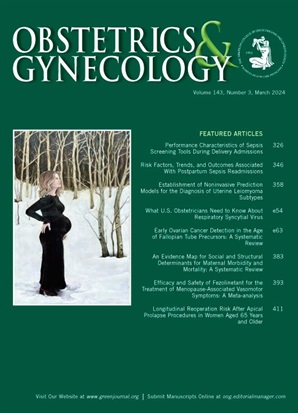良性指征子宫切除术的社区社会经济脆弱性和围手术期并发症。
IF 4.7
2区 医学
Q1 OBSTETRICS & GYNECOLOGY
引用次数: 0
摘要
目的评价社区社会经济脆弱性(以Vizient脆弱性指数衡量)与良性子宫切除术后围手术期并发症之间的关系。方法本回顾性队列研究使用Vizient临床数据库,分析2015-2024年因良性适应症行子宫切除术的患者。根据9个社会经济领域的人口普查区数据,将患者分为VVI四分位数(四分位数1,最不脆弱;四分位数4,最脆弱):公共安全、交通、社会凝聚力、环境质量、住房、社区资源、医疗保健获取、教育和收入。主要观察指标是围手术期并发症的发生情况,用Clavien-Dindo评分将其分为严重、轻微或任何并发症。采用Logistic回归估计邻里脆弱性与手术并发症之间的关系。额外的分析评估了特定的个人和社区层面的社会决定因素的关联,包括种族作为结构性种族主义暴露的标志,以及围手术期结果。结果1055338例患者中,18.4% (n= 194002)发生并发症,其中重度并发症4.4% (n= 46356),轻度并发症16.0% (n= 169361)。并发症发生率在VVI四分位数中呈比例增加(P< 0.001)。严重并发症从四分位1的3.6%上升到四分位4的5.7%;轻微并发症由13.8%增加到19.8%;并发症从15.9%上升到22.5%。与四分位数1相比,较高的VVI四分位数与主要、轻微和任何并发症的发生率增加相关,其中四分位数4的影响最大。调整后,四分位数3和四分位数4的相关性仍然显著。合并症是最强的个体水平预测因子。黑人种族,作为结构性种族主义暴露的标志,与所有VVI四分位数的并发症风险独立相关。结论:作为衡量社区社会脆弱性的指标,VVI与良性适应症子宫切除术围手术期并发症相关,与个体因素无关。与最不脆弱的四分位数患者相比,两个最脆弱的四分位数患者的预后较差。种族差异,特别是对黑人患者的影响,在VVI类别中持续存在,反映了结构性种族主义和邻里不平等的综合影响。本文章由计算机程序翻译,如有差异,请以英文原文为准。
Neighborhood-Level Socioeconomic Vulnerability and Perioperative Complications in Hysterectomy for Benign Indications.
OBJECTIVE
To evaluate the association between neighborhood-level socioeconomic vulnerability, measured by the VVI (Vizient Vulnerability Index) and perioperative complications after hysterectomy for benign conditions.
METHODS
This retrospective cohort study analyzed patients who underwent hysterectomy for benign indications (2015-2024) using the Vizient Clinical Database. Patients were categorized into VVI quartiles (quartile 1, least vulnerable; quartile 4, most vulnerable) based on census tract data across nine socioeconomic domains: public safety, transportation, social cohesion, environmental quality, housing, neighborhood resources, health care access, education, and income. The primary outcome was the occurrence of perioperative complications, classified as major, minor, or any complication, with the Clavien-Dindo scale. Logistic regression was used to estimate the association between neighborhood vulnerability and surgical complications. Additional analyses evaluated the association of specific individual- and neighborhood-level social determinants, with race included as a marker of structural racism exposure, and perioperative outcomes.
RESULTS
Among 1,055,338 patients, 18.4% (n=194,002) experienced complications, including 4.4% (n=46,356) major and 16.0% (n=169,361) minor complications. Complication rates increased proportionally across VVI quartiles (P<.001). Major complications rose from 3.6% in quartile 1 to 5.7% in quartile 4; minor complications increased from 13.8% to 19.8%; and any complications increased from 15.9% to 22.5%. Higher VVI quartiles were associated with increased odds of major, minor, and any complications compared with quartile 1, with the strongest effects in quartile 4. After adjustment, the association remained significant for quartiles 3 and 4. Comorbidities were the strongest individual-level predictor. Black race, as a marker of structural racism exposure, was independently associated with complication risk across all VVI quartiles.
CONCLUSION
We demonstrate that VVI, a measure of neighborhood-level social vulnerability, is associated with perioperative complications at the time of hysterectomy for benign indications independently of individual-level factors. Patients in the two most vulnerable quartiles experienced poorer outcomes compared with those in the least vulnerable quartile. Racial disparities, particularly affecting Black patients, persisted across VVI categories, reflecting the compounded influence of structural racism and neighborhood inequities.
求助全文
通过发布文献求助,成功后即可免费获取论文全文。
去求助
来源期刊

Obstetrics and gynecology
医学-妇产科学
CiteScore
11.10
自引率
4.20%
发文量
867
审稿时长
1 months
期刊介绍:
"Obstetrics & Gynecology," affectionately known as "The Green Journal," is the official publication of the American College of Obstetricians and Gynecologists (ACOG). Since its inception in 1953, the journal has been dedicated to advancing the clinical practice of obstetrics and gynecology, as well as related fields. The journal's mission is to promote excellence in these areas by publishing a diverse range of articles that cover translational and clinical topics.
"Obstetrics & Gynecology" provides a platform for the dissemination of evidence-based research, clinical guidelines, and expert opinions that are essential for the continuous improvement of women's health care. The journal's content is designed to inform and educate obstetricians, gynecologists, and other healthcare professionals, ensuring that they stay abreast of the latest developments and best practices in their field.
 求助内容:
求助内容: 应助结果提醒方式:
应助结果提醒方式:


